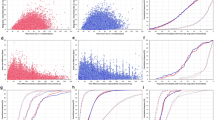Abstract
Background
Most drugs with systemic bioavailability have to undergo a thorough QT (TQT) study, which includes a pharmacologic positive control. A set of QTc-quality tests was recently proposed with the possible aim of removing the need for a positive control.
Objective
We evaluated the influence of QT measurement and QTc computation methodology on the proposed QTc-quality tests.
Methods
The baseline ECG waveforms and fiducial points were retrieved from 34 crossover TQT studies that had full-day baseline ECGs prior to each study period. The QT measurement methodology and recorder type were retrieved from study reports. The influence of QTc computation methodology was investigated by applying the pattern-matching technique and/or using the 10-s average heart rate.
Results
There were no statistical differences in any QTc-quality test values between studies using continuous or 10-s bedside recordings and, in a subset of the quality test, an increase of data quality for semi-automatically read studies compared with those manually read (p < 0.01). There was a significant improvement (p < 0.01) in all the QTc-quality test values for QTc measurements obtained by using pattern matching with or without 10-s average heart rate in comparison to the original QTc measurements.
Conclusion
The findings suggest that QTc quality is mostly driven by the QTc measurement methodology rather than other study-related factors.

Similar content being viewed by others
References
ICH. Guidance for Industry E14 clinical evaluation of QT/QTc interval prolongation and proarrhythmic potential for non-antiarrhythmic drugs. 2005.
ICH. Guidance for industry E14 clinical evaluation of QT/QTc interval prolongation and proarrhythmic potential for non-antiarrhythmic drugs. Questions and answers; 2008.
Malik M, Zhang J, Johannesen L, Hnatkova K, Garnett C. Assessing electrocardiographic data quality and possible replacement of pharmacological positive control in thorough QT/QTc studies by investigations of drug-free QTc stability. Heart Rhythm. 2011;8(11):1777–85.
Johannesen L, Garnett C, Malik M. Impact of electrocardiographic data quality on moxifloxacin response in thorough QT/QTc studies. Drug Saf. 2014. doi:10.1007/s40264-014-0142-2
Hnatkova K, Smetana P, Toman O, Bauer A, Schmidt G, Malik M. Systematic comparisons of electrocardiographic morphology increase the precision of QT interval measurement. Pacing Clin Electrophysiol. 2009;32(1):119–30.
Fridericia LS. Die Systolendauer im Elektrokardiogramm bei normalen Menschen und bei Herzkranken. Acta Med Scand. 1920;54(1):170.
Badilini F, Vaglio M, Sarapa N. Automatic extraction of ECG strips from continuous 12-lead Holter recordings for QT analysis at prescheduled versus optimized time points. Ann Noninvasive Electrocardiol. 2009;14(Suppl 1):S22–9.
Meyer O, Ferber G, Greig G, Holzgrefe HH. Pattern recognition analysis of digital ECGs: decreased QT measurement error and improved precision compared to semi-automated methods. J Electrocardiol. 2013;46(2):118–25.
Malik M, Hnatkova K, Novotny T, Schmidt G. Subject-specific profiles of QT/RR hysteresis. Am J Physiol Heart Circ Physiol. 2008;295(6):H2356–63.
Natekar M, Hingorani P, Gupta P, Karnad DR, Kothari S, de Vries M, et al. Effect of number of replicate electrocardiograms recorded at each time point in a thorough QT study on sample size and study cost. J Clin Pharmacol. 2011;51(6):908–14.
Acknowledgments
The opinions presented here are those of the authors and no official support or endorsement by the FDA is intended or should be inferred. Marek Malik is an Honorary ORISE Research Fellow of the FDA. Lars Johannesen, Christine Garnett, and Marek Malik have no conflicts of interest directly related to this article.
The authors are grateful to Dr. Norman Stockbridge of the FDA for his substantial guidance on the topic and his help with preparing this manuscript. This project was supported in part by an appointment to the Research Participation Program at the Center for Drug Evaluation and Research administered by the Oak Ridge Institute for Science and Education through an interagency agreement between the US Department of Energy and the FDA.
Author information
Authors and Affiliations
Corresponding author
Rights and permissions
About this article
Cite this article
Johannesen, L., Garnett, C. & Malik, M. Electrocardiographic Data Quality in Thorough QT/QTc Studies. Drug Saf 37, 191–197 (2014). https://doi.org/10.1007/s40264-014-0140-4
Published:
Issue Date:
DOI: https://doi.org/10.1007/s40264-014-0140-4




